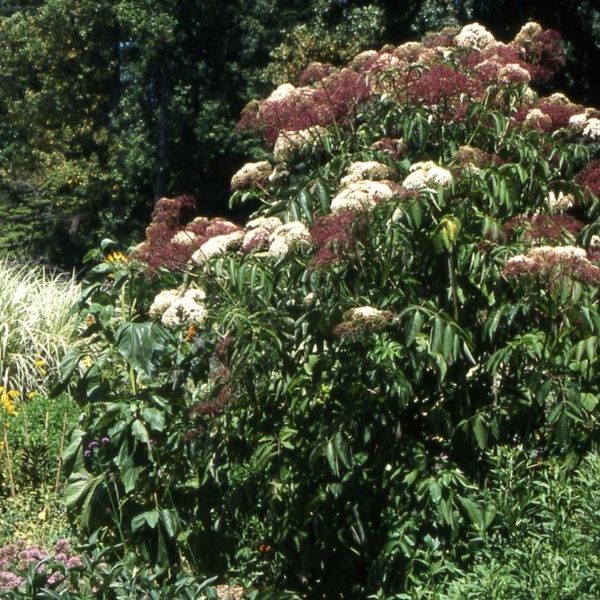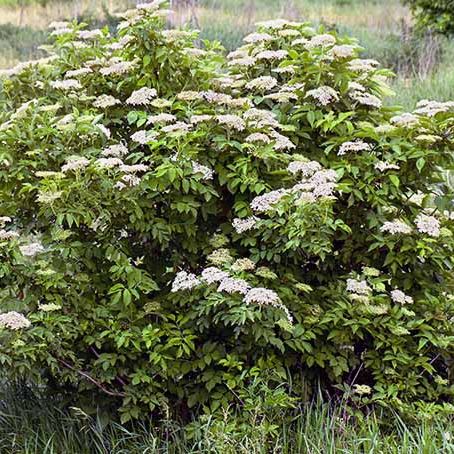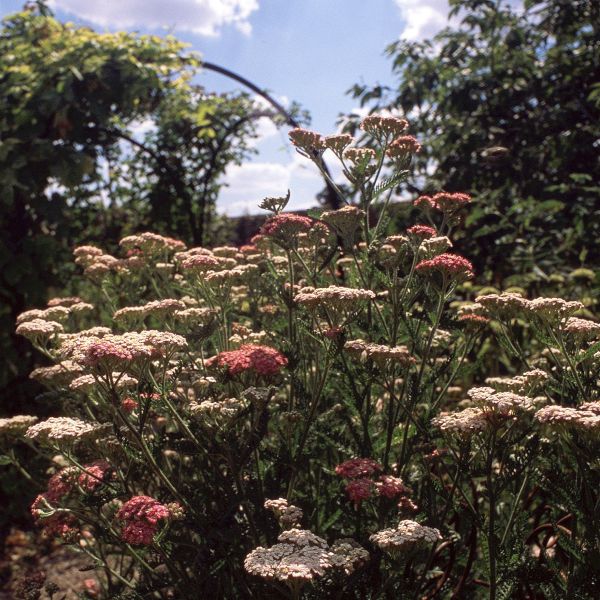


Adams Elderberry
Sambucus canadensis 'Adams'
94 reviews
Adams Elderberry
Sambucus canadensis 'Adams'
94 reviews
2.5 Gallon
We are sorry, product is currently out of stock due to seasonal availability. Please check the "Related plants available in your area" section below
Not just beautiful - intentionally selected by ShrubHub's 3D landscape design team to fit real-world spaces and maximize yard potential.
Why Adams Elderberry?
Adams Elderberry (Sambucus canadensis 'Adams') is a popular cultivar due to its vigorous growth and abundant fruit production. This deciduous shrub features deep purple-black berries that are rich in antioxidants and can be used for making jams, jellies, and wine. The plant's compact size makes it suitable for small gardens, and it also attracts pollinators and birds, adding beauty and biodiversity to the landscape.
Sunlight
Adams Elderberry plants require full sun exposure to thrive and produce abundant fruit.
Watering
Adams Elderberry plants require regular watering, especially during the first year of growth. They prefer moist soil but can tolerate short periods of drought once established. It is important to avoid overwatering, as this can lead to root rot.
Fertilizing
Adams Elderberry plants require regular fertilization with a balanced fertilizer to promote healthy growth and fruit production. The specific fertilizer requirements may vary, so it is best to consult with a local horticulturist or nursery for the most app
Adams Elderberry
The Adams Elderberry (Sambucus canadensis 'Adams') is a deciduous shrub known for its stunning clusters of white flowers and edible dark purple berries. This plant is native to North America and belongs to the honeysuckle family.
Features:
- Size: The Adams Elderberry typically grows to a height of 8-10 feet and spreads about 6-8 feet wide. It has an upright, multi-stemmed growth habit.
- Foliage: The shrub showcases attractive deep green compound leaves that consist of 5-9 toothed leaflets arranged opposite each other. The foliage turns a beautiful yellow color in the fall.
- Flowers: In late spring to early summer, the Adams Elderberry produces an abundance of large, flat clusters of fragrant white flowers. These flowers are not only visually appealing but also attract pollinators, such as bees and butterflies, to your garden.
- Berries: One of the standout features of the Adams Elderberry is its showy clusters of dark purple berries that ripen in late summer. These berries are small, juicy, and possess a sweet-tart flavor. They can be used in various culinary applications, including jams, jellies, pies, and wines.
- Hardiness: This elderberry cultivar is highly adaptable and thrives in USDA hardiness zones 3-8. It can withstand cold winters and has good resistance to disease and pests.
- Uses: The Adams Elderberry is a versatile plant that can be used in different landscaping settings. It can be grown as a focal point in your garden, as a hedge, or as part of a mixed border. Additionally, its edible berries make it a great addition to edible landscaping or a wildlife garden.
- Care: This elderberry cultivar prefers full sun to partial shade and well-drained soil. It is adaptable to different soil types, including clay and sandy soil. Regular watering is necessary, especially during the plant's first year. Pruning can be done in late winter or early spring to maintain its shape and promote healthy growth.
Overall, the Adams Elderberry is an attractive shrub that offers not only aesthetic beauty but also provides edible berries for culinary purposes. With its adaptability and low maintenance requirements, it is an excellent choice for any garden or landscape.
Plant Information:
| Botanical Name: | Sambucus canadensis 'Adams' |
| USDA Zones: | 3 - 9 |
| Water: | Moderate to Low |
| Exposure: | Full Sun |
| Soil Needs: | Well Drained |
| Mature Height: | 8 - 10 feet |
| Mature Spread: | 8 - 10 feet |








Pollination Info
Adams Elderberry (Sambucus canadensis 'Adams')
Sambucus canadensis 'Adams,' commonly known as Adams Elderberry, is a deciduous shrub native to North America. It is a cultivar of the Sambucus canadensis species, specifically selected for its improved fruit production.
Pollination
Adams Elderberry is not self-fertile, meaning it requires cross-pollination from another compatible elderberry plant to produce fruit. It belongs to the category of plants referred to as "dioecious," which means male and female flowers are borne on separate plants.
Planting Considerations
To ensure successful pollination and a bountiful harvest of elderberries, it is recommended to plant at least two different elderberry varieties in proximity to one another. This allows for cross-pollination between male and female plants, as they generally rely on insect activity, particularly bees, for transferring pollen between flowers.
Compatible Pollinators
When selecting companion plants for Adams Elderberry, consider other Sambucus canadensis cultivars, such as 'York' or 'Johns.' These will have compatible flowering times and can serve as effective pollinators for each other. Additionally, wild elderberry plants in the vicinity can also contribute to cross-pollination.
Optimal Pollination Conditions
Pollination in Adams Elderberry is most successful when the weather is favorable for insect activity, especially during the flowering period. Bees and other pollinators are more active on warm, sunny days. Providing a variety of flowering plants in the garden can help attract and support pollinators.
Hand Pollination
If there is a lack of compatible elderberry plants nearby, or if pollinator activity is insufficient, hand pollination can be done to ensure fruit set. This involves transferring pollen from the male flowers to the female flowers using a small brush, cotton swab, or by gently shaking the flowers within the same plant.
Fruit Development
After successful pollination, the flowers of Adams Elderberry will develop into small green berries, which gradually turn red and then dark purple or black as they mature. The berries are ready for harvest when they are plump, juicy, and easily detach from the cluster.
Conclusion
To maximize the fruit production of Sambucus canadensis 'Adams' elderberries, planting at least two different elderberry plants in close proximity is recommended for efficient cross-pollination. Ensure suitable conditions for pollinator activity and consider hand pollination if necessary. With proper care, you can enjoy a bountiful harvest of delicious elderberries!
FAQ
FAQ - Adams Elderberry (Sambucus canadensis 'Adams')
1. What is Adams Elderberry (Sambucus canadensis 'Adams')?
Adams Elderberry (Sambucus canadensis 'Adams') is a cultivar of the elderberry plant scientifically known as Sambucus canadensis. It is a deciduous shrub that produces clusters of small white flowers in the spring, followed by dark purple berries in the summer. It is popular for its attractive foliage, edible berries, and its ability to attract pollinators.
2. How can I identify Adams Elderberry (Sambucus canadensis 'Adams')?
Adams Elderberry can be identified by its medium to large size, reaching a height of around 6 to 10 feet and a spread of 6 to 8 feet. It has a rounded form with multiple stems and deep green leaves. The flowers are small, white, and appear in broad, flat-topped clusters. The dark purple berries that follow are typically quite abundant.
3. Where should I plant Adams Elderberry?
Adams Elderberry thrives in full sun to partial shade conditions. Ideally, it should be planted in well-drained soil with average moisture. It is adaptable to various soil types, including sandy and clay soils. It can be planted as a standalone shrub in a garden or used as a hedge. However, make sure to provide enough space for its growth.
4. How do I care for Adams Elderberry?
Here are some care tips for Adams Elderberry:
- Water regularly, especially during dry periods, to keep the soil moist but not waterlogged.
- Apply a layer of organic mulch around the base of the plant to retain moisture and suppress weeds.
- Prune in late winter or early spring to remove dead or damaged wood and to promote new growth.
- Fertilize in early spring with a balanced fertilizer formulated for shrubs.
- Monitor for pests or diseases, such as aphids or powdery mildew, and take appropriate action if necessary.
5. When does Adams Elderberry bloom and produce berries?
Adams Elderberry typically blooms in late spring to early summer, usually around May or June, depending on the specific climate conditions. The flowers are followed by the development of berries, which ripen from green to deep purple or black in mid to late summer.
6. Are the berries of Adams Elderberry edible?
Yes, the berries of Adams Elderberry are edible. They are rich in antioxidants and can be used in various culinary preparations like jams, jellies, pies, and wines. However, it is important to note that the berries should be cooked before consumption as raw elderberries can cause stomach upset.
7. Can I grow Adams Elderberry in containers?
While it is possible to grow Adams Elderberry in containers, it is generally more suitable for growing in the ground. The size of the plant and its spreading nature may require a larger container, and adequate care should be taken to ensure proper drainage to prevent root rot. Consider choosing a compact cultivar if you intend to grow it in a container.
8. Are there any specific companion plants for Adams Elderberry?
Adams Elderberry can be paired with various plants to create an attractive and beneficial garden. Some suitable companion plants include:
- Lavender
- Roses
- Lilies
- Echinacea
- Rudbeckia
- Salvia
Planting & Care
Planting Adams Elderberry (Sambucus canadensis 'Adams')
Planting Requirements:
- Sun Exposure: Adams Elderberry requires full sun to partial shade. Choose a location that receives at least 6 hours of direct sunlight per day.
- Soil: It thrives in well-drained, loamy soil. A pH range of 5.5 to 6.5 is ideal for optimal growth.
- Spacing: Space Adams Elderberry plants 6-8 feet apart to ensure proper air circulation and accommodate their mature size.
- Timing: Plant Adams Elderberry in early spring or late fall when the soil is workable and temperatures are cooler.
Planting Steps:
- Choose a suitable location with adequate sunlight.
- Prepare the soil by removing any weeds, rocks, or debris.
- Dig a hole that is slightly wider and deeper than the root ball of the Adams Elderberry plant.
- Place the plant in the hole, ensuring the top of the root ball is level with or slightly above the soil surface.
- Backfill the hole with soil, gently firming it around the roots to remove air pockets.
- Water the newly planted elderberry thoroughly to settle the soil.
- Apply a layer of mulch around the plant, leaving a small gap around the stem to prevent rot.
Care Tips:
- Watering: Keep the soil consistently moist but not waterlogged. Water deeply once a week, especially during dry periods.
- Fertilization: Adams Elderberry generally doesn't need excessive fertilization if planted in nutrient-rich soil. However, a balanced slow-release fertilizer can be applied in early spring.
- Pruning: Prune Adams Elderberry during late winter or early spring to maintain its shape and remove any dead or damaged branches. This will encourage new growth and higher fruit production.
- Pest and Disease Control: Adams Elderberry is relatively resistant to pests and diseases. However, keeping the plants healthy and well-maintained will reduce the risk of any potential issues. Monitor for aphids, spider mites, and powdery mildew.
- Harvesting: The elderberries will ripen in late summer to early fall. Harvest the dark purple berries when they are fully ripe, and use them for culinary purposes or preserving.
Following these planting and care instructions will help your Adams Elderberry thrive and provide you with beautiful foliage and flavorful berries.
Check Out These Verified Customer Reviews:
Customer Reviews
4.6 out of 5 based on 94 reviews
Thank you! Your review has been submitted.
Website was user-friendly, elderberry was fantastic.
I love the vibrant color of the elderberries and the taste is amazing. Will definitely order again!
The Adams Elderberry arrived quickly and in perfect condition. The quality of the product exceeded my expectations. The website was easy to navigate and the customer service was excellent.
Item has been added to your cart.


